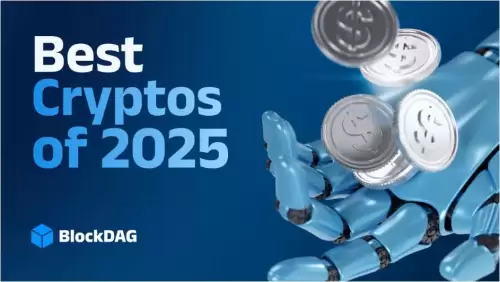 |
|
 |
|
 |
|
 |
|
 |
|
 |
|
 |
|
 |
|
 |
|
 |
|
 |
|
 |
|
 |
|
 |
|
 |
|
加密貨幣新聞文章
Leemon Baird, the Inventor of Hashgraph, Explains How It Works as an Alternative to Blockchain Architectures
2025/05/13 01:06

Leemon Baird, co-founder of Hedera Hashgraph, is no stranger to the world of technology. With a background in computer science and a career spanning both academia and industry, Baird is uniquely positioned to provide insights into the promise and potential of blockchain technology.
In a recent interview with CoinDesk, Baird discussed his journey developing hashgraph consensus, the technical limitations of earlier approaches that he was trying to address, and his vision for the future of blockchain and AI.
“I love computer science and the math side of it—inventing things and solving problems. When I became an entrepreneur 25 years ago, it was the same process,” Baird said.
“The core of what I always do is trying to understand the fundamental problem we're trying to solve. What is the real question? What are we really trying to accomplish? And then you build on that and solve that problem.”
Baird explained that he began working on hashgraph consensus in 2012, motivated by his interest in exploring new possibilities within the realm of mathematics.
“I started working on this in 2012 as one of many math problems I was exploring. Initially, I was convinced it couldn't be done. I'd pick up the problem, play with it, and convince myself it was impossible—over and over again,” Baird said.
“But in 2015, I realized that by throwing in two hashes, suddenly it all falls into place. You can have ultimate speed—essentially at the speed of the internet—while also having ultimate security with ABFT. And it's proof of stake, so you don't waste electricity.”
According to Baird, the problem he was trying to solve was how to create a consensus mechanism that could be both fast and secure. Existing mechanisms, such as Bitcoin's proof of work, were either slow or not fully asynchronous Byzantine fault tolerant (ABFT).
“I asked: Is it possible to achieve ABFT—the strongest kind of security—while also being super fast and not burning electricity or dumping carbon into the atmosphere?” Baird said.
Hashgraph, he explained, is able to achieve both speed and security because it uses a novel approach to consensus that is based on directed acyclic graphs (DAGs).
“This new structure allows for very rapid consensus times—on the order of a few seconds—while still maintaining the high levels of security that are essential for a trustless system of this magnitude,” Baird said.
Baird also emphasized the importance of governance in his decision to co-found Hedera.
“From a business perspective, the question was: what is the right way to govern this? When we look at blockchains, they often claim, ‘We won't have any governance. Anyone can help do it.’ But power over time can consolidate—you end up with a handful of developers or people behind the scenes controlling everything,” Baird said.
“We started differently. We made governance decentralized from the very beginning. We brought in some of the biggest organizations in the world—top universities and businesses spread globally that people trust and that have reputations to be upheld. They balance each other, creating checks and balances, and together they govern the system.”
According to Baird, this structure of governance is what allows Hedera to be trusted by such a wide range of organizations.
“It was about addressing the fundamental question: what do you really want in governance? What will give you true trustlessness, or at least a lower bar of trust needed to fully trust the system?” Baird said.
“That was our answer—approaching business questions with the same rigor as mathematical ones.”
In addition to its technical capabilities, Baird highlighted several use cases that are being developed on Hedera.
“We're seeing a lot of interesting use cases emerge, especially in the realm of real-world asset tokenization,” Baird said.
“For instance, we're tracking carbon emissions with Hyundai and Kia, and they're using this data to report on their progress towards sustainability goals.”
According to Baird, this capability is crucial for organizations that are subject to increasing pressure to reduce their carbon footprints.
“As large organizations like Hyundai and Kia deploy their products and services across the globe, they're generating massive amounts of data that needs to be stored, tracked, and ultimately reported on,” Baird said.
“This is where blockchain technology can play a vital role. By leveraging the immutable and transparent nature of blockchain, we can create a system of record for carbon emissions that is both reliable and verifiable.”
Baird also mentioned several other use cases that are being developed on Hedera, including stablecoins, AIs, and RWA tokenization.
“We've created a Stable Coin Studio to make developing and deploying stablecoins on Hedera seamless, and we're seeing great potential in this area, especially with the Hedera Council members, many of whom are financial institutions who are actively working on various stablecoin
免責聲明:info@kdj.com
所提供的資訊並非交易建議。 kDJ.com對任何基於本文提供的資訊進行的投資不承擔任何責任。加密貨幣波動性較大,建議您充分研究後謹慎投資!
如果您認為本網站使用的內容侵犯了您的版權,請立即聯絡我們(info@kdj.com),我們將及時刪除。
-

- 比特幣採礦移動:2025年的應用程序和策略
- 2025-07-27 00:00:07
- 探索2025年移動比特幣採礦應用程序的興起,為日常投資者提供了被動收入機會和創新的收入策略。這是加密的未來嗎?
-

-

-

- 區塊鏈,股票和黃金:財務整合的新時代
- 2025-07-27 00:00:00
- 隨著傳統財務包含分散技術,探索區塊鏈,股票和黃金的融合。發現最新的趨勢和見解,以塑造投資的未來。
-

- 加密貨幣:塊狀,vechain(獸醫)和山寨幣的變化沙子
- 2025-07-26 23:56:57
- 探索諸如Blockdag,Vechain(VET)等加密貨幣的動力,突出了投資者的關鍵趨勢和見解。
-

- 2025年要觀看的加密貨幣:頂級分析師的精选和模因硬幣躁狂症
- 2025-07-26 23:45:00
- 頂級分析師正在關注2025年具有真正實用性和社區炒作的加密貨幣。深入研究趨勢和見解,塑造了數字資產的未來。
-

- IOTA價格和合規性:機構採用如何塑造未來
- 2025-07-26 23:43:55
- IOTA通過盧卡(Lukka)等合作夥伴關係加上不斷上漲的交易數量和開發商的利益,推動了機構合規性,正在影響其價格和長期潛力。
-

-





























































